How to turn on the air conditioner for heating: the specifics of setting the system to operate for heat
When the heat that a home has accumulated over the summer has already run out, and the central heating has not yet been connected, an annual period of temperature discomfort occurs. How to survive it without chills and colds?
You can, of course, turn on the heater, but why not use the installed split system? After all, most modern air conditioners successfully perform both functions: cooling and heating. Information about the capabilities of the technology is indicated in his passport.
All that remains is to figure out how to turn on the air conditioner for heating, and also find out the features of operating the split in the cold season. These issues have been studied by us and described in detail in the article.
The content of the article:
- What to choose for effective heating
- Air conditioners: general information and classification
- Basics of the design and operation of an air conditioner
- Nuances of operation in the cold season
- Turn on the system in heating mode
- Impact of installation on system operation
- Conclusions and useful video on the topic
What to choose for effective heating
Dank autumn weather should not disturb the usual state of comfort in your apartment. How can we regain a feeling of comfort and peace that does not fit in with the numerous clothes with which we try to protect ourselves and loved ones from the omnipresent cold and colds?
To regulate the temperature in your home, there is a whole arsenal of popular devices ready to help you:
- gas burners;
- infrared heaters;
- fan heaters;
- convectors;
- oil radiators.
By the way, the air conditioner, which saved us from the scorching rays of the sun all summer, is also capable of perfectly heating the room.And he will do this in the shortest possible time, which distinguishes him from the competitors listed above.
Another advantage is that it not only does not dry out the air, but even slightly moisturizes it. But that's not all. The main advantage is the cost-effectiveness of the air conditioner for heating. The energy that is necessary for the operation of the device is spent not on heating the air, but on transporting heat into the room from the outside.
To determine the performance of modern air conditioners, the EER (Energy Efficiency Ratio) coefficient is used, which reflects the ratio of heat or cold production (for heating or cooling, respectively) to energy costs.
So, modern EER models have more than 4 units - when consuming 1 kW of energy, they can provide 4 kW of heat.
Air conditioners: general information and classification
Human health, performance and quality of life depend on the state of the environment. So that external disasters have less impact on us, we create our own comfortable microclimate in the rooms where we sleep, live, and work.
The creation, use and improvement of air conditioning is humanity’s response to nature, its way of protection.
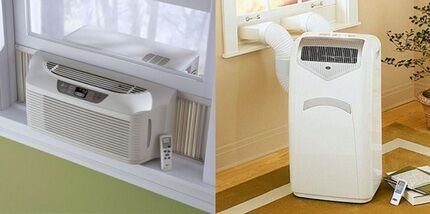
Most modern models of this device are familiar to us:
- window and mobile all-in-one PCs;
- split systems.
In turn, split systems, consisting of outdoor and indoor units, are divided into:
- Wall mounted. This option is most often used in offices and residential premises.
- Columned. They look like powerful columns and are used in conference rooms, restaurants and hotel lobbies to supply air into the ceiling space and then distribute it.
- Ceiling. The air flow from them is directed along the ceiling or wall. They consist of an indoor unit and an air duct system for flow distribution. These are predominantly cassette options installed in the attic or hidden behind suspended ceiling systems.
Multisystems are used to process large objects. They are characterized by the presence of one common outdoor unit and several indoor units connected to a common outdoor unit and located in different rooms.
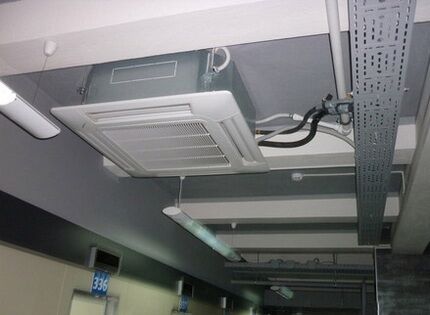
Main characteristics that distinguish one model from another:
- power consumption;
- performance;
- acoustic comfort;
- a set of functions included in the model: cooling, heating, air ionization, dehumidification, cleaning, etc.
Prices for models from different brands depend not only on the listed characteristics, but also on the class of the device.

All models can be divided into three classes:
- Budget. Easy to operate, quite noisy, but affordable devices that lack a number of non-critical functions: protection against improper operation, for example; This class is represented mainly by trademarks of domestic, Chinese and Korean manufacturers, including models LG And air conditioners Samsung.
- Middle class. Still noisy, but reliable products, characterized by increased durability, the presence of control functions and an average price range. This may include products Toshiba And Delonghi.
- Elite. These devices cannot be called cheap, but all the best qualities are concentrated in them: high efficiency, durability, silent operation, reliability, the possibility of self-diagnosis and all levels of protection. This is, for example, products Panasonic And splits from Daikin.
Regardless of what class a truly modern air conditioner can be classified into, it must be:
- equipped with a remote control;
- not only cool, but heat and dry the air;
- work in ventilation mode;
- maintain the specified operating parameters in automatic mode;
- have an on/off timer.
By the way, cooling and heating are two sides of the same process that occurs in a split system.
Basics of the design and operation of an air conditioner
Regardless of what specific type your device is, the set of its basic functional elements is not very diverse. These are the evaporator, condenser, compressor, fan and valve (throttle).
A system of thin copper pipes that connects all elements of the device, except the fan, allows a special substance to move through them - refrigerant, which is usually used as freon. The physical state of the refrigerant during operation of the air conditioner changes from gaseous to liquid and vice versa.
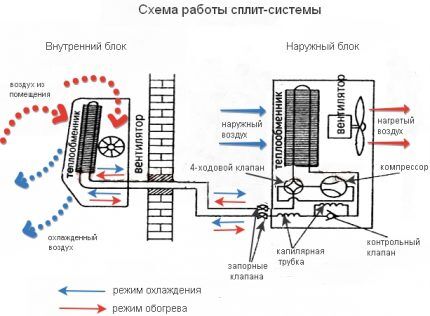
If you turn on the device in cooling mode, the following processes will occur.
The gaseous refrigerant enters the compressor, where it is compressed while simultaneously increasing pressure and temperature. In the condenser, where the freon will subsequently flow, it will turn into liquid, releasing the resulting heat to the environment. The fan assists the process.
As the refrigerant passes the throttle (valve), it will increase in volume, losing pressure and temperature. Having entered the evaporator, it again begins to acquire a gaseous state, evaporating and absorbing heat from the air in the room. When the freon enters the compressor again, the cycle is completed and resumed.
If the air conditioner operates for heating, the process will occur in the reverse order. In this case, the compressor pumps heat from the compressed freon towards the room, and the evaporator will work as a condenser.
To visualize air conditioner operating procedure, you can watch the video posted in the final part of the article.
Nuances of operation in the cold season
Our goal is to stay warm without damaging the device we are going to use.Achieving it is very simple - you need to listen to the opinion of the manufacturer, which is contained in the product’s operating instructions.
The document indicates the temperature range in which the product will operate efficiently and stably. For most models - from minus 5 to plus 25 °C.
But in summer we often turn on the air conditioner even at high ambient temperatures. The consequences of such excess of operating temperatures are a decrease in the performance of the device. However, it does not fail. In winter, violation of the recommended operating mode can lead to very disastrous results.
Why is this happening? In the most popular models, the condenser and compressor are located in the outdoor unit.
When the temperature drops below that stated in the Instructions, the aggregate state of the oil in the compressor crankcase also changes: it becomes thicker and ceases to envelop the moving elements of the device. This negatively affects their operational life.
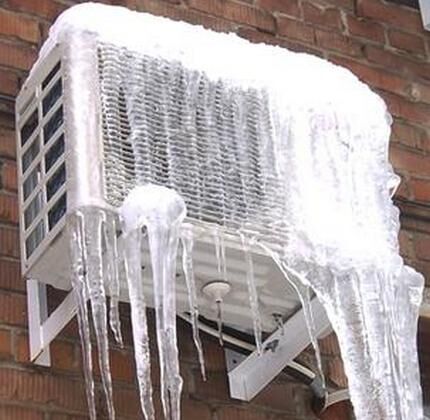
By the way, in the summer, violation of the regime also does not go away completely without a trace. If the outdoor unit of the system is located on the sunny side, it is subject to serious overheating, which can also cause the oil to thicken. At the same time, rubbing parts deprived of lubrication wear out faster.
When performing the heating function, heat from the environment must be transferred into the room. This refrigerant, moving through the outdoor unit's condenser (or evaporator), receives it from the street air.If the temperature of this air is too low, the freon does not heat up as necessary, and the thermal efficiency of the split system decreases.
In addition, the evaporator-condenser and compressor heat up during operation. Upon contact with cold air masses, the surface of the parts becomes covered with condensation, which quickly turns into ice deposits. Under such conditions, the device simply stops working.
However, this is not the only reason for its failure. Frosty air leads to a malfunction in the phase transitions of the refrigerant. In the evaporator, freon does not go into a gaseous state, as it should be under operating conditions. Entering the compressor in this state, it can cause hydraulic shock.
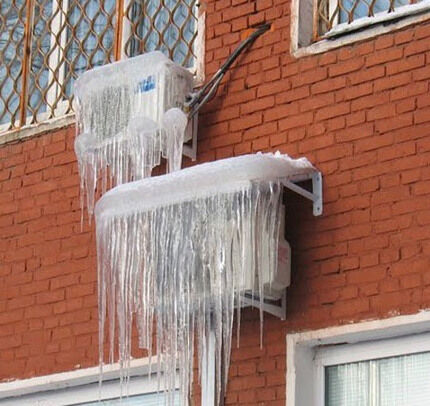
When the air conditioner operates in cooling mode, a large air flow passes through it. When it comes into contact with the surfaces of the condenser and evaporator, condensation is formed, which is removed to the outside using the drainage system. For drainage, a hose is used, located downwards at an angle.
By turning on the device for cooling in winter, we risk getting a plug of frozen water in the drainage hose. Condensate that has ceased to be discharged outside will inevitably enter the air conditioner, disrupting its operation.
Of course, expanding the temperature range of safe operation of products is one of the primary tasks of manufacturers of all models. To do this, they introduce, for example, systems for heating the oil in the compressor or heating the drainage. The result is impressive.
For example, products TOSHIBA, specially designed for northern countries, can be successfully operated even at -20°C.
Turn on the system in heating mode
When operating a split system, try not to use the random method, study the Instructions, because there are many models on the market and each manufacturer of this product tries to add its own twist to the simple rules of operation.
We will try to describe several options for setting the air conditioner to heat and bringing it to the state we need.
# Option one
There should be a “MODE” button on the remote control. It can be located under the cover. If you still find it, click on it until you see the “sun” icon or the inscription “HEAT”.

Using the “+” and “-” buttons, we will select a temperature regime at which we will feel comfortable. Do not forget that for all actions that you perform, the remote control must be directed towards the device, which will receive signals sent to it and respond to them with emitted sound.
You can perform all the specified settings on the remote control, and then direct it to the air conditioner by pressing the “ON” button. The desired changes must occur within five minutes.
When switching on to heating mode, the fan in the indoor unit will not turn on immediately.
# Option two
You took a good look at your remote control, but you didn’t find the “MODE” key either on it or under the cover. But you see the icons “droplet”, “fan”, “snowflake” and “sun”. We need “sunshine”, and we choose it.

We set the temperature so that it is higher than what is already in the room. For example, if you currently have +18°C, set it to +25°C so that the difference is felt immediately. Again, we make sure that the signal is received by the system. With a wireless remote control, the response will be a sound, with a wired one, a light will light up on the front of the unit.
After about five minutes you should feel the result of your adjustment.
# Option three
There are no keys on the remote control labeled “MODE” or “HEAT”. There is also no “sun” icon, although “fan”, “snowflake” and, possibly, “droplet” are present.
This indicates that your model is not designed to heat a room. Don't demand from her what she can't give you.
# Option four
The desired mode can be set directly on the air conditioner. To do this, turn on the device by pressing the power button. Let's find the "MODE" mode selection key, with which we set the operating mode we need.
We press this key until the “HEAT” we need appears. As a rule, this function will be the fifth after automatic mode, cooling, drying and ventilation.
Now we will need a remote control to set the desired temperature. With its help, you can order the desired rotation speed of the device’s fan.
Pay attention to the operating temperature range, which is probably indicated in the form of a plate for your specific model in the Instructions. Please follow these manufacturer's recommendations to ensure you can enjoy a properly functioning split system for as long as possible.
# Option five (sad)
It doesn’t matter when the system does not provide heating for the simple reason that it is not included in the list of its functions. But this is certainly an inexpensive model that will honestly delight you on hot summer days. It is much worse when you purchased an expensive model and know for sure that it simply must work for heating, but you cannot start the process.
At the same time, you performed all the necessary operations in full accordance with the Instructions, which you still had to look into, but the result was not obtained not only after the five promised minutes, but even after an hour. Checking the batteries in the remote control did not clarify the situation: they turned out to be serviceable.
Well, you have to repair your air conditioner. Perhaps the cause of the breakdown was improper installation of the device, which should only be performed by people who know what and how it will work subsequently. Now, if you don’t want to completely destroy the device, disconnect it from the power source and look for a repairman. Further operation of the device is not yet possible.
Impact of installation on system operation
It is wrong to assume that the split system will work properly, regardless of who installed it and how. But no. Installing such a complex device is a rather complicated process. It has its own nuances and tricks that you need to know and take into account.
Since the device itself is not a cheap pleasure, it would be strange to save on its installation rather than safely ruin it.

Mistakes made on installation stage, can lead to insufficient heating of the space when the device should be working for heating. One of the common mistakes is improper organization of air circulation. Air masses must not only have unhindered access to the system, but also free outflow from it.
You should pay careful attention to the following installation points:
- the external unit should not be flush against the wall: it must be secured at a sufficient distance using brackets or anchors;
- The strictly horizontal installation of the block should be checked using a building level;
- for the air conditioner it is better to provide a separate circuit breaker on the panel and its own cable;
- protect the external unit with a special canopy from precipitation and direct sunlight;
- moisture should not stagnate inside the system, which means that the drainage tube should be installed at an angle;
- there may be a certain height difference between the indoor and outdoor units, but within reasonable limits: no more than 20 m;
- It is better not to install the indoor unit directly above radiators or other heat sources; there cannot be curtains in the air path, and there must be at least three meters between the device and the furniture;
- Avoid positioning the device in such a way that the air currents emanating from it will be directed directly at people - it’s easy to get pneumonia in such conditions, even in the summer heat.
Do not wait for breakdowns or other incomprehensible situations to start studying the Instructions. Knowing the features of your purchase, the rules of its operation and the nuances of caring for it will help you use it not only for a long time, but also for your health and not to its detriment.
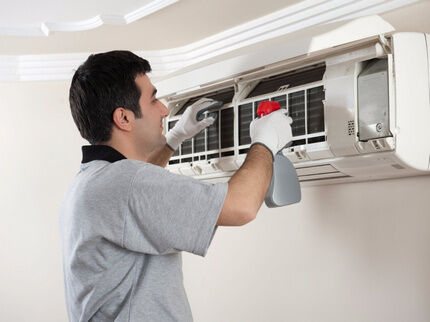
Cleaning the device, changing its filters or refilling the refrigerant are the functions of a specialized organization. Do not try to repair the air conditioner yourself - it is dangerous. Turn off the power and invite a repairman.
However, if you are used to doing everything yourself and are confident in your own abilities, then we recommend that you first study the rules split system maintenance.
Conclusions and useful video on the topic
To understand exactly how an air conditioner works, you need to visualize the whole process visually. A small but very informative video that we bring to your attention will help you do this.
If installing a system is a complex job that must be carried out by specialists, then switching the device from cooling (or any other) mode to heating is an elementary process that you need to learn how to do yourself.
However, we have a video aimed at those who would rather see it once than read it a hundred times.
You will find out the answers to the questions of what happens to the air conditioner if you turn it on for heating at significant subzero temperatures by watching this video.
Modern appliances bring comfort to our lives. They are designed to make us feel better, regardless of external weather conditions. To use the opportunities they provide us to the fullest, we need to know the rules of their operation.
In this case, the air conditioner will provide you not with bronchitis and pneumonia, but with good health and excellent well-being.
Do you have experience using an air conditioner in heating mode? Tell us how effective this option is, and whether this split system option was useful for you. You can leave comments on the publication and participate in discussions in the form below.




A really useful function, I use it even in the summer, when there is a lot of rain and the temperature drops below 15 degrees, it always helps out. Turning on the heating mode is not so difficult, at least on my model there were no problems. In the fall, it almost always works in this mode until the heating is turned on; previously we used a heater, but it uses up too much electricity.
Yes, I also tried to somehow turn on the heating, but either something went wrong, or the device needed repairs, and an incomprehensible technical smell appeared in the air. So I don’t turn it on yet, I’m waiting for the master to come and check. And the information can be very useful. I’ll also clarify with a specialist those points that I would like to use after reading the text. For example, how to avoid damage to the air conditioner in winter.
Most likely this “technical” smell is plastic. Inexpensive split systems are guilty of this. You need to check if the plastic is melting. If not, the smell will go away after a while.